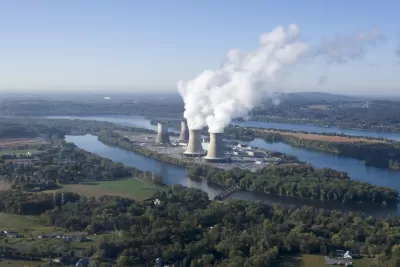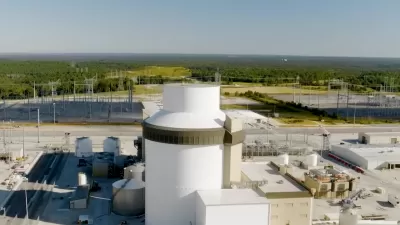Nuclear regulators have recently given the green light to a new kind of nuclear reactor, the small modular reactor. A recent article in The Urbanist explains the case for a nuclear-powered urbanism.

Shaun Kuo provides news and commentary about innovation in the nuclear power sector that might position nuclear power as a resource for the goals of urbanism.
First, the news: The "Department of Energy recently approved a multi-year cost share award of up $1.355 billion to a new entity, the Carbon Free Power Project, to demonstrate and deploy a 12-module small modular reactor (SMR) power plant," according to Kuo. That funding award follows additional news from August that the U.S. Nuclear Regulatory Commission gave first-ever design approval for an SMR for a power plant expected to be built by 2029. NuScale Power designed the 720-megawatt plant, and Utah Associated Municipal Power Systems (UAMPS), which owns the Carbon Free Power Project, hopes to begin construction on the SMR by 2025 at its planned location at the Idaho National Laboratory.
"UAMPS will be distributing energy from the plant to their participating public power utility customers in Utah, California, Idaho, Nevada, New Mexico, and Wyoming. UAMPS CEO noted that this project will complement and enable additional intermittent renewable energy, wind and solar that are a growing part of the agency’s portfolio," according to the article.
After explaining how SMRs differ from the nuclear reactors of history, Kuo ties those distinctions to a question of density, and suggests that SMRs enable a community-level approach to the future deployment of nuclear power. "Whether or not SMRs fit into the niches demanded by our urban areas, it will have to depend on the needs of each community to develop energy portfolios," writes Kuo.
FULL STORY: An Urbanist Case for Small Nuclear Power Reactors

Alabama: Trump Terminates Settlements for Black Communities Harmed By Raw Sewage
Trump deemed the landmark civil rights agreement “illegal DEI and environmental justice policy.”

Study: Maui’s Plan to Convert Vacation Rentals to Long-Term Housing Could Cause Nearly $1 Billion Economic Loss
The plan would reduce visitor accommodation by 25% resulting in 1,900 jobs lost.

Planetizen Federal Action Tracker
A weekly monitor of how Trump’s orders and actions are impacting planners and planning in America.

Waymo Gets Permission to Map SF’s Market Street
If allowed to operate on the traffic-restricted street, Waymo’s autonomous taxis would have a leg up over ride-hailing competitors — and counter the city’s efforts to grow bike and pedestrian on the thoroughfare.

Parklet Symposium Highlights the Success of Shared Spaces
Parklets got a boost during the Covid-19 pandemic, when the concept was translated to outdoor dining programs that offered restaurants a lifeline during the shutdown.

Federal Homelessness Agency Places Entire Staff on Leave
The U.S. Interagency Council on Homelessness is the only federal agency dedicated to preventing and ending homelessness.
Urban Design for Planners 1: Software Tools
This six-course series explores essential urban design concepts using open source software and equips planners with the tools they need to participate fully in the urban design process.
Planning for Universal Design
Learn the tools for implementing Universal Design in planning regulations.
Caltrans
Smith Gee Studio
Institute for Housing and Urban Development Studies (IHS)
City of Grandview
Harvard GSD Executive Education
Toledo-Lucas County Plan Commissions
Salt Lake City
NYU Wagner Graduate School of Public Service





























